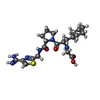Entry Database : PDB / ID : 2feqTitle orally active thrombin inhibitors Decapeptide Hirudin Analogue Thrombin heavy chain Thrombin light chain Keywords / / Function / homology Function Domain/homology Component
/ / / / / / / / / / / / / / / / / / / / / / / / / / / / / / / / / / / / / / / / / / / / / / / / / / / / / / / / / / / / / / / / / / / / / / / / / / / / / / / / / / / / / / / / / / / / / / / / / / / / / / / / / / / / / / / / / / / / Biological species Homo sapiens (human)Hirudo medicinalis (medicinal leech)Synthetic (others) Method / / Resolution : 2.44 Å Authors Mack, H. / Baucke, D. / Hornberger, W. / Lange, U.E.W. / Hoeffken, H.W. Journal : Bioorg.Med.Chem.Lett. / Year : 2006Title : Orally active thrombin inhibitors. Part 1: optimization of the P1-moietyAuthors : Mack, H. / Baucke, D. / Hornberger, W. / Lange, U.E.W. / Seitz, W. / Hoeffken, H.W. History Deposition Dec 16, 2005 Deposition site / Processing site Revision 1.0 Aug 8, 2006 Provider / Type Revision 1.1 May 1, 2008 Group Revision 1.2 Jul 13, 2011 Group Atomic model / Database references ... Atomic model / Database references / Derived calculations / Non-polymer description / Structure summary / Version format compliance Revision 1.3 Dec 12, 2012 Group Revision 1.4 Oct 18, 2017 Group / Category / Item Revision 1.5 Apr 4, 2018 Group / Category / Item Revision 1.6 Mar 26, 2025 Group Data collection / Database references ... Data collection / Database references / Derived calculations / Structure summary Category chem_comp_atom / chem_comp_bond ... chem_comp_atom / chem_comp_bond / database_2 / pdbx_entry_details / pdbx_modification_feature / struct_conn / struct_site Item _database_2.pdbx_DOI / _database_2.pdbx_database_accession ... _database_2.pdbx_DOI / _database_2.pdbx_database_accession / _struct_conn.pdbx_leaving_atom_flag / _struct_site.pdbx_auth_asym_id / _struct_site.pdbx_auth_comp_id / _struct_site.pdbx_auth_seq_id
Show all Show less
 Open data
Open data Basic information
Basic information Components
Components Keywords
Keywords Function and homology information
Function and homology information Homo sapiens (human)
Homo sapiens (human) Hirudo medicinalis (medicinal leech)
Hirudo medicinalis (medicinal leech) X-RAY DIFFRACTION /
X-RAY DIFFRACTION /  MOLECULAR REPLACEMENT / Resolution: 2.44 Å
MOLECULAR REPLACEMENT / Resolution: 2.44 Å  Authors
Authors Citation
Citation Journal: Bioorg.Med.Chem.Lett. / Year: 2006
Journal: Bioorg.Med.Chem.Lett. / Year: 2006 Structure visualization
Structure visualization Molmil
Molmil Jmol/JSmol
Jmol/JSmol Downloads & links
Downloads & links Download
Download 2feq.cif.gz
2feq.cif.gz PDBx/mmCIF format
PDBx/mmCIF format pdb2feq.ent.gz
pdb2feq.ent.gz PDB format
PDB format 2feq.json.gz
2feq.json.gz PDBx/mmJSON format
PDBx/mmJSON format Other downloads
Other downloads 2feq_validation.pdf.gz
2feq_validation.pdf.gz wwPDB validaton report
wwPDB validaton report 2feq_full_validation.pdf.gz
2feq_full_validation.pdf.gz 2feq_validation.xml.gz
2feq_validation.xml.gz 2feq_validation.cif.gz
2feq_validation.cif.gz https://data.pdbj.org/pub/pdb/validation_reports/fe/2feq
https://data.pdbj.org/pub/pdb/validation_reports/fe/2feq ftp://data.pdbj.org/pub/pdb/validation_reports/fe/2feq
ftp://data.pdbj.org/pub/pdb/validation_reports/fe/2feq Links
Links Assembly
Assembly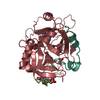
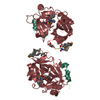
 Components
Components Homo sapiens (human) / References: UniProt: P00734, thrombin
Homo sapiens (human) / References: UniProt: P00734, thrombin Homo sapiens (human) / References: UniProt: P00734, thrombin
Homo sapiens (human) / References: UniProt: P00734, thrombin X-RAY DIFFRACTION / Number of used crystals: 1
X-RAY DIFFRACTION / Number of used crystals: 1  Sample preparation
Sample preparation ROTATING ANODE / Type: RIGAKU RU200 / Wavelength: 1.5418 Å
ROTATING ANODE / Type: RIGAKU RU200 / Wavelength: 1.5418 Å Processing
Processing MOLECULAR REPLACEMENT / Resolution: 2.44→50.3 Å / Isotropic thermal model: isotropic / σ(F): 0 / Stereochemistry target values: Engh & Huber
MOLECULAR REPLACEMENT / Resolution: 2.44→50.3 Å / Isotropic thermal model: isotropic / σ(F): 0 / Stereochemistry target values: Engh & Huber Movie
Movie Controller
Controller



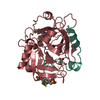
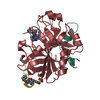
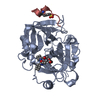
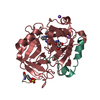
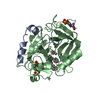
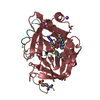

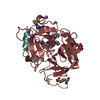
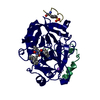


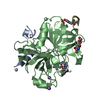

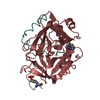

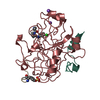
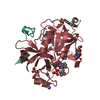
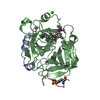
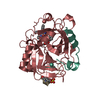
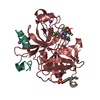
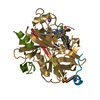
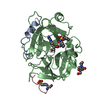
 PDBj
PDBj










